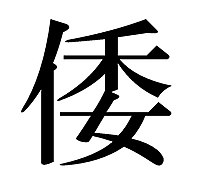Wa (name of Japan)

Wa (倭) (Chinese pronunciation: Wō; Japanese pronunciation: Wa; Korean pronunciation: Wae) is an ancient name of Japan used by ancient Chinese, Korean, and Japanese dynasties. Today the character for Wa is often written as 和 (also pronounced Wa) in the Japanese language. For example, "English-Japanese Dictionary" in Japanese is Ei-Wa Jiten (英和辞典), where Wa in this usage refers to the Japanese language. The first written record of Japan (then in the Yayoi period, 300 BC-250 AD) is found as Wō in Wei Zhi (魏志) of San Guo Zhi. Japanese had also called themselves or their country as Wa until the end of 7th century.
Etymology
The character 倭 is also believed to have the meaning "dwarf". The character is related to the standard character for "short" (矮, as in 矮人), which is written with a different radical (an "arrow", instead of a "person", with the same phonetic element). Another theory says the word meant "docile".[citation needed] It is uncertain whether the character first referred to the Japanese as a people, or if it was a pre-existing word that was borrowed to refer to the Japanese. Both theories are plausible, since ancient Chinese names for non-Chinese peoples often carried pejorative meanings, although it is not definite that the kanji was used in a pejorative way from the start.
In either case, the Japanese were often stereotyped as being short in stature in ancient China and Korea, a stereotype which has only lost its currency in the 20th century. However, it is often used by the government of North Korea colloquially in anti-Japanese propaganda).
Because of this connotation, the Japanese subsituted the character 倭 (dwarf) with 和 (harmony); the latter character is also pronounced wa in Japanese. Due to sensitivity of its connotations, today the character 倭 is only used in historical contexts[citation needed]
Contacts with the state of Wu (5th century BCE)
Ambassadoral visits to Japan by the later Northern Chinese dynasties Wei and Jin Dynasty (265-420) (Encounters of the Eastern Barbarians, Wei Chronicles) recorded that the Japanese people claimed to be descendents of Taibo of the Kingdom of Wu (吳国), refugees after the fall of the Wu state in the 5th century BC (History books do have records of Wu Taibo sending 4000 males and 4000 females to Japan). Historical records also show that the ancient Japanese had similar lifestyles and customs as pre-Sinicized inhabitants of the Wu Kingdom, including tattooing, ritual teeth pulling and baby-carrying on backs.
- 魏略:「倭人自謂太伯之後。」
- 晉書:「自謂太伯之後,又言上古使詣中國,皆自稱大夫。」 列傳第六十七 四夷
- 資治通鑑:「今日本又云吳太伯之後,蓋吳亡,其支庶入海為倭。」
The Wa in the Liang-Shu (7th century)
The 7th century Chinese chronicle Book of Liang (Liangshu, Chinese: 梁書) describe the Wa as a Japanese people apparently living in Kyushu, in the Kingdom of Yamatai.
The people are all tattoed. Their territory is about 12,000 li (1,500 kilometers) from our realm, roughly to the east of Guiji (modern Shaoxing (Zhejiang)). To get there, it is necessary to follow the coast and go beyond the Korean state to the south-east for about 500 kilometers, then for the first time cross a sea to a small island 75 kilometers away, then cross the sea again for 75 kilometers to Miro country (Chinese: 未盧國, modern Tosu city in Saga Prefecture, Japan). 50 kilometers to the southeast is the country of Ito (Chinese: 伊都國). 10 kilometers to the southeast is the country of Nu (Chinese: 奴國). 10 kilometers to the east is the country of "Bumi" (Chinese: 不彌國). 20 days to the south by boat is the country of "Touma" (Chinese: 投馬國). 10 days to the south by boat or one month by land is the country of Yamatai (Chinese: 邪馬臺國). There resides the King of the Wa people. (Chinese: 倭者 自云太伯之後 俗皆文身 去帶方萬二千餘里 大抵在會稽之東 相去絶遠 從帶方至倭 循海水行 歴韓國 乍東乍南 七千餘里始度一海 海闊千餘里 名瀚海 至一支國 又度一海千餘里 名未盧國 又東南陸行五百里 至伊都國 又東南行百里 至奴國 又東行百里 至不彌國 又南水行二十日 至投馬國 又南水行十日 陸行一月日 至邪馬臺國 即倭王所居, Liang Shu, 7th century)
